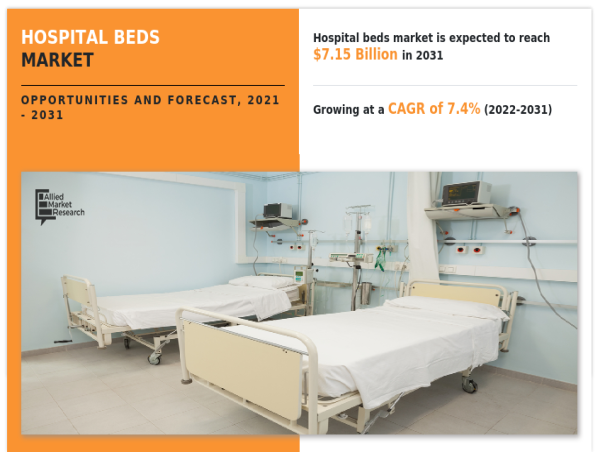What Are Hospital Beds and Why Are They Important?
Hospital beds are specially designed medical furniture that offers:
Adjustable positions to raise or lower the head, foot, or midsection.
Improved comfort for patients.
Greater efficiency and safety for caregivers.
Get a Sample Copy of this Report: https://www.alliedmarketresearch.com/request-sample/A15374
They are essential in a wide range of healthcare settings—from emergency departments and ICUs to long-term care and home healthcare environments.
Key Market Drivers
1. Rising Road Accidents and Surgeries
According to the U.S. NHTSA, around 38,680 deaths were reported in motor vehicle accidents in 2020.
Increased surgical interventions require enhanced patient accommodation, contributing to the demand for hospital beds.
2. Growth of the Geriatric Population
As per Eurostat, over 20.8% of the EU population in 2021 was aged 65 or older.
Elderly individuals are more prone to chronic conditions, falls, and bone fractures, increasing hospitalization rates.
3. Increase in Chronic Diseases
According to the World Health Organization (WHO), cancer led to nearly 10 million deaths in 2020.
Rising incidence of diabetes, hypertension, and cardiovascular diseases leads to a greater need for long-term care, boosting demand for advanced hospital beds.
4. Technological Advancements and Product Innovation
In 2021, Stryker launched ProCuity, a fully wireless hospital bed designed to reduce patient falls and improve staff workflow.
Integration of smart technology in hospital beds is revolutionizing patient care and monitoring.
Market Trends and Opportunities
✓ Growing Healthcare Expenditure
U.S. healthcare spending rose by 9.7% in 2020, reaching $4.1 trillion.
This increase reflects a global trend of higher investment in healthcare infrastructure.
✓ COVID-19 Impact
The pandemic accelerated demand for hospital beds due to:
Rising hospital admissions.
Expansion of isolation wards.
Awareness of home-based medical care.
According to the FDA (2020), demand for beds, stretchers, and mattresses surged during the public health emergency.
✓ Surge in Medical Tourism
Lower-cost treatments in countries like India and Thailand have made medical tourism a driver of hospital bed demand.
Investments in private hospitals and ambulatory surgical centers contribute to market expansion.
Segmentation Overview
By Technology:
Powered Beds (Dominant Segment)
Includes electric and semi-electric models.
Popular for convenience and patient safety.
Manual Beds
More affordable, suitable for low-resource settings.
Expected to grow due to affordability and geriatric care use.
By Application:
Long-term Care (Largest segment in 2021)
Serves patients with chronic conditions and rehabilitation needs.
Acute Care
Expected to grow significantly due to trauma cases and rising surgical procedures.
By End User:
Hospitals (Dominant)
Increased number of hospitals and government healthcare reforms.
Ambulatory Surgical Centers
Rapid growth expected due to cancer prevalence and outpatient surgical trends.
Regional Insights
Asia-Pacific (APAC):
Held the largest market share in 2021.
Driven by:
Large patient population.
Rise in chronic diseases.
Expanding healthcare investments.
Strong presence of manufacturing companies.
Europe:
Expected to register significant growth.
Factors include:
High rate of elderly population.
Strong healthcare infrastructure.
Growing awareness of patient safety standards.
Key Market Players
Major companies operating in the hospital beds market include:
Stryker Corporation
Linet SPOL S.R.O.
Getinge AB
Medline Industries Inc.
Invacare Corporation
Paramount Bed Holdings
Burke Bariatric Inc.
Drive Medical
Amico Corporation
Midmark Corporation
Savaria Corporation
Graham Field
Stiegelmeyer GmbH & Co
Antano Group S.R.L.
Med-Mizer Inc
Novum Medical Technology
These players are focusing on product development, technological innovation, and strategic collaborations to capture a larger share of the growing hospital beds market.
Conclusion
The hospital beds market is witnessing dynamic growth, fueled by rising chronic illnesses, aging demographics, and technological breakthroughs. The post-pandemic healthcare focus and government investment in infrastructure will further accelerate demand for advanced and smart hospital bed systems.
🔑 Key Takeaways:
Market to grow from $3.39B (2021) to $7.15B (2031) at 7.4% CAGR.
Asia-Pacific leads the market; Europe shows strong growth potential.
Powered beds and long-term care applications dominate.
Innovations like wireless hospital beds are redefining patient care.
Enquire Before Buying: https://www.alliedmarketresearch.com/purchase-enquiry/A15374
David Correa
Allied Market Research
+1 800-792-5285
email us here
Visit us on social media:
LinkedIn
Facebook
YouTube
X
Legal Disclaimer:
EIN Presswire provides this news content "as is" without warranty of any kind. We do not accept any responsibility or liability for the accuracy, content, images, videos, licenses, completeness, legality, or reliability of the information contained in this article. If you have any complaints or copyright issues related to this article, kindly contact the author above.
![]()




